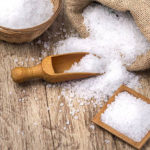Adding oil to boiling water
When boiling vegetables, many people usually just add salt. However, you can also add a little bit of oil to the boiling water. The oil will create a thin layer on the outside, making your vegetables greener and shinier.
In addition, the layer of oil can help the vegetables stay green for a longer time without changing color. However, the boiled water will have some oily residue, so it depends on your taste preference whether to use it or not.
Along with the tip of adding oil, you can also apply the following tips to make your boiled vegetables tastier.

Do not soak vegetables in water for too long
Many people have the habit of soaking vegetables in water or salt water to remove dirt and toxins. But soaking vegetables for too long is not good. Some types of vegetables can easily get mushy if soaked for too long. Soaking chopped vegetables in water will dissolve the vitamins into the water, and the toxins can seep back into the vegetables.
If you want to soak vegetables, you should only soak them in salt water for 5-10 minutes and then remove them. After rinsing the vegetables thoroughly, cut them into small pieces if necessary.
Turn up the heat to boil water vigorously
Usually, people think that as long as the water is boiling before adding vegetables, the vegetables won’t get overcooked. But in reality, after boiling for about 5 minutes, the vegetables will start to lose their vibrant color. The reason is that many people don’t wait for the water to reach a vigorous boil before adding the vegetables.
Many people immediately add the vegetables when the water is just starting to boil, causing the water to lose heat and take some time to boil again. That’s why you should turn up the heat, wait for the water to reach a vigorous boil, and then add the vegetables. The water will continue to boil quickly, and you just need to remove the vegetables when they are done.

Immediately transfer the boiled vegetables to ice water
When the vegetables are cooked, you can immediately transfer them to a bowl of ice water. Doing so will help the vegetables stay crunchy and maintain their natural green color.
Furthermore, you should eat the boiled vegetables as soon as possible. If left for too long, the vegetables will lose nutrients and look less appealing.
Add salt to the boiling water for vegetables
Salt not only enhances the flavor of boiled vegetables but also helps them retain their vibrant green color after cooking. When the water is boiling, add a small amount of salt to preserve the color of the vegetables. A reasonable ratio is one small spoonful of salt for every half a liter of boiling water.

Ensure the boiled vegetables are fully submerged
If you boil vegetables with too little water, it can ruin your dish. The reason is that when the water is not enough to fully submerge the vegetables, the parts of the vegetables that are above the water level will not cook at the same time as the parts that are submerged. As a result, the vegetables will not be evenly cooked.
Source: Xe và thể thao (translated and modified)
Water at Home to Help with Acne’>How to Steam Face with Salt Water at Home to Help with Acne
Maximizing Durability and Energy Efficiency with High-Speed Kettles: Tips and Advice
Are you an electric kettle aficionado? If so, you’ll appreciate Ði?n máy Xanh’s latest offering. We’ve compiled comprehensive instructions to help you make the most of your electric kettle, including tips on how to prolong its life as well as maximize energy savings. Let’s get your kettle expertise up to date!



































